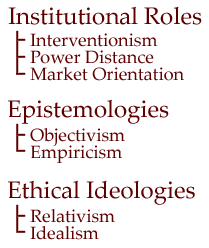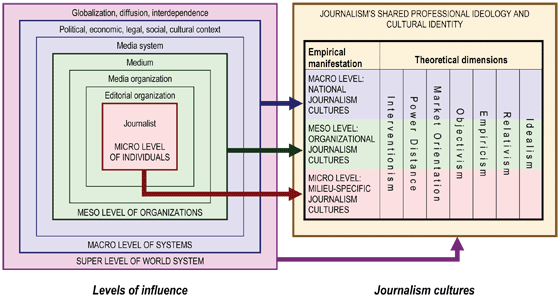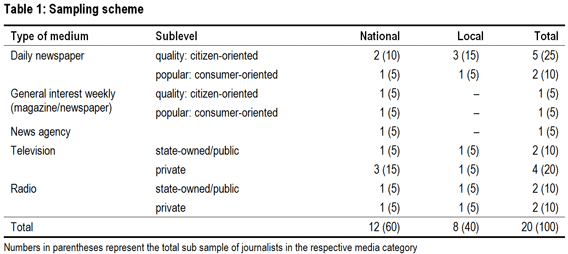WJS 2007–2011 Pilot Study
Conceptualization: journalism culture and influences
One important point of departure of the pilot study was a conceptualization that models diversity in journalistic cultures in terms of three constituents:
(1) The area of institutional roles refers to the normative and actual functions of journalism in society that are mostly referred to as role perceptions. Three dimensions are of particular relevance here: Interventionism reflects the extent to which journalists pursue a particular mission and promote certain values. The distinction tracks along a divide between two ideal-types of journalist – one involved and socially committed; the other detached and uninvolved. Power distance refers to a journalist’s position toward loci of power in society. It distinguishes between an approach to journalism as “Fourth Estate” and “watchdog” on the one hand, and an opportunist, loyal or collaborative mode toward power centers on the other. Market orientation accounts for the journalists’ perspectives on the audience as either citizens or consumers. In the latter perspective, journalism cultures strongly submit to the market logic, while the former approach gives priority to the public interest and the creation of an informed citizenry.
(2) The domain of journalistic epistemologies relates to the accessibility of reality and the nature of acceptable evidence. Here, objectivism marks the distinction between two fundamental beliefs: One claims the existence of an objective truth “out there” that can be reported “as it is”, the other concedes that news is an inevitably subjective representation of the world. Empiricism, on the other hand, refers to the relative weight given to an empirical justification of truth, emphasizing observation, measurement, evidence and experience, and an analytical justification by accentuating reason, ideas, values, opinions and analysis.
(3) The domain of ethical ideologies points to the question of how journalists respond to ethical dilemmas. Here, we conceptualized ethical views in journalism along two basic dimensions: Relativism marks the extent to which journalists base their personal moral philosophies on universal ethical rules. While many journalists believe that ethical decisions are very much dependent on the situational context, others argue that professional ethics is universal and journalists should rely on moral absolutes regardless of the actual context. Idealism refers to the importance of consequences in journalists’ reasoning about ethical dilemmas. Highly idealistic journalists are means-oriented as they believe that desirable consequences should always be obtained with the “right” action. Less idealistic journalists, on the other hand, are more goal-oriented for they admit that harm will sometimes be necessary to produce a greater public good.

Influences on journalism were modeled along four general levels (see Figure below): The super level of the world system mainly influences journalism via processes of globalization, diffusion and interdependence. The macro-level of societies (nations) primarily shapes journalism through the political, economic, legal, social and cultural contexts, as well as the properties of the media system in general. On the meso-level of organizations, influences on organizational journalism cultures stem from the editorial organization, the media organization and the medium as such (e.g. newspapers vs. television). Finally, the micro-level of individuals reflects the journalists’ backgrounds and individual characteristics.

Methodology: multilevel data collection
The research tools used in this study were collaboratively developed in order to guarantee a maximum degree of intercultural validity. Altogether 21 countries participated in the pilot study: Australia, Austria, Brazil, Bulgaria, Chile, China, Egypt, Germany, Greece, Indonesia, Israel, Mexico, Pakistan, Portugal, Romania, Russia, Spain, Switzerland, Turkey, Uganda and the United States. In each of these countries we conducted interviews with a quota sample of 100 working journalists drawn from 20 news organizations. Interviews were mostly completed between October 2007 and January 2010 by telephone or face-to-face. In addition to the interviews we also collected data on their news organizations and on relevant properties of their media systems.
Sampling was carried out in two steps. We first selected 20 news organizations in every country according to a common quota scheme (see Table). Wherever possible we selected five journalists in each newsroom. Journalists were defined as those who had at least some “editorial responsibility” for the content they produce. From all 413 newsrooms that were chosen in the first place, 28 refused to cooperate and were subsequently replaced. On the level of the journalists, we had to substitute 266 interviewees from the altogether 2100 journalists due to refusal.

